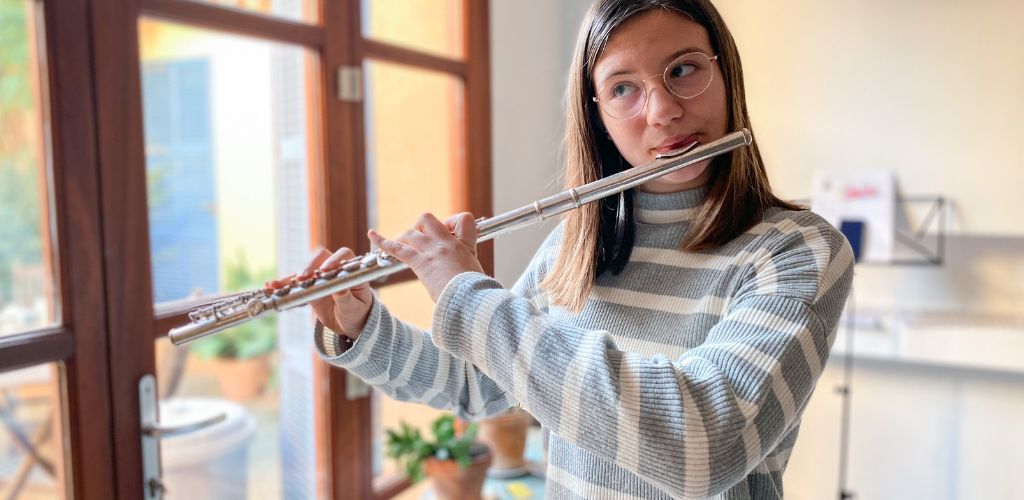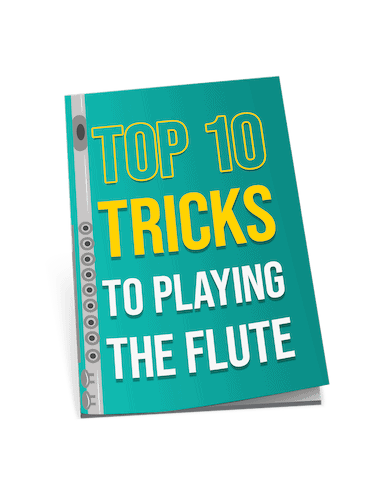Best
Affordable Beginner Flute
-
Overall: Without an E mechanism for personal preference
-
Best Feature: Has responsive sound with superb intonation
-
TedScore™: 9/10
Best
Overall
Beginner
Flute
-
Overall: Delivers a responsive sound with superb intonation
-
Best Feature: Allows a more natural hand shape with its offset G and split-E mechanism
-
TedScore™: 8/10
Best
Intermediate
Flute
-
Overall: Traditional craftsmanship combined with modern innovation.
-
Best Feature: Silver-plated head joint, body, and foot joint.
-
TedScore™: 9/10
Have you ever been mesmerized by the elegant sounds of a flute and wondered, “How Does the Flute Work?”
The secret lies in directing a focused stream of air across the mouth hole, causing vibrations that produce those magical notes. As a woodwind instrument, the flute channels your breath into a rhythmic dance that transforms air into melody.

From the mouth hole to the sound holes, each part plays a crucial role in shaping its distinctive sound. The flutist controls pitch and tone by altering breath and manipulating keys, making for a truly interactive musical experience.
I’m fascinated by how this slender musical instrument crafts its charming tunes. Keep reading to explore the captivating mechanics behind these melodious pipes.
Understanding the Flute's Anatomy and Sound Mechanics
As a flutist, I’m often captivated by the way a modern flute transforms breath into music. This intricate instrument consists of several components, each playing a critical role in sound production.
Components of the Flute

The flute comprises three main parts: the head joint, the body, and the foot joint. The head joint houses the lip plate and embouchure hole, where I focus my breath.
This is where the sound begins. The body of the flute is adorned with tone holes.
These holes create different pitches when covered or released. Lastly, the foot joint extends the flute’s range, allowing me to play lower notes.
Together, these parts form the full range of a woodwind instrument. Understanding these components aids in mastering the flute.
The Science of Flute Sound Production
Sound on the flute arises from vibrations within its air column. When I blow across the embouchure hole, I initiate these vibrations. The air splits at the hole’s edge, setting the column in motion.

By covering and uncovering tone holes, I modify the effective length of this air column. This alters the vibrational patterns, producing different pitches and harmonics.
Each adjustment requires precise control to maintain the desired tone and quality. Pressure and technique play a huge role here, determining both tone production and sound clarity.
Embouchure and Airflow
Embouchure and breath control are pivotal in flute performance. My lips form a precise shape to direct air across the embouchure hole. This focused airflow is essential for generating sound.
Proper embouchure involves maintaining consistent pressure and angle, which can affect tone and volume. Breath control ensures the air column remains steady, fostering an even and resonant sound.
By honing these skills, I can create expressive music that ranges from whispers to powerful crescendos. Mastery in these areas is key to expressive flute playing.

Techniques for
Flute Mastery
Mastering the flute is a beautiful journey filled with exploration and skill development. By focusing on key areas such as fingering, tone, and expressive playing, a flutist can significantly enhance their musical artistry.

Fingering and Note Production
Fingering is the foundation of producing clear and accurate notes on the flute. It’s crucial to develop flexible and precise finger movements to enable fluent transitions between notes.
I practice using a fingering chart
Posture is equally important. I always maintain a relaxed stance, ensuring my flute is aligned with my lips and arms in a comfortable position.
Tuning and Tone Improvement
Achieving the right intonation and tone requires careful attention to tuning and dynamics. I frequently check my pitch against a tuner to ensure accuracy. Regular tuning exercises develop my ear and refine my pitch control.
Long-tone exercises are part of my daily regimen to achieve a warm and resonant tone. These involve holding a note steadily and focusing on smooth and sustained air support.
Expressive Playing and Advanced Techniques
Expressive playing brings music to life, and I explore various advanced techniques to enhance my performance.
Dynamics and power are critical; I experiment with varying air speeds and articulations to convey emotion.
I also incorporate extended techniques such as flutter tonguing and harmonics to create a richer palette of sounds. Experimenting with these sounds can elevate my musical expression.
Balancing technical skills with expressive flair transforms my musical journey into a rewarding and inspiring experience.
Flute Model Recommendation
Yamaha YFL212 Student Model Flute

FEATURES: Responsive sound with superb intonation
OTHER INFO: Nickel silver body for durability
Yamaha YFL212 Student Model Flute
- Offers comfortable playing with offset G and E-mechanism
- Ideal for students seeking to develop their skills
- Register for 5-year extended warranty and 3-months Tomplay Premium
- Higher price range compared to other beginner flutes
When you click ‘Check Price’, you’ll see there are loads of great places to buy this item. Our personal favorite is Sweetwater for the US, and Thomann and Gear4Music for the UK & Europe.
They are the largest music retailers, with excellent customer service, competitive prices, really fast shipping, and the longest guarantees.
The professional musician who wrote this article combined many things,
from the product build, manufacturer’s reputation through to feedback
from other users, to create our famous TedScore™.
Yamaha YFL-222 Student Flute with Offset G Key System

DESIGNED FOR: Beginners
FEATURES: The design is based on Yamaha's Professional Series flutes.
OTHER INFO: Nickel silver construction provides increased durability and a rich tone.
Yamaha YFL-222 Student Flute with Offset G Key System
- Hand-assembled silver-plated keys.
- Comfortable offset G key system.
- Includes case.
- While some players find the offset G key comfortable, others may prefer an inline G key system, so it's a matter of personal preference.
When you click ‘Check Price’, you’ll see there are loads of great places to buy this item. Our personal favorite is Sweetwater for the US, and Thomann and Gear4Music for the UK & Europe.
They are the largest music retailers, with excellent customer service, competitive prices, really fast shipping, and the longest guarantees.
The professional musician who wrote this article combined many things,
from the product build, manufacturer’s reputation through to feedback
from other users, to create our famous TedScore™.
Pearl Flutes 505RBE1RB Intermediate Flute

FEATURES: Traditional craftsmanship combined with modern innovation.
OTHER INFO: Silver-plated head joint, body, and foot joint.
- Hand-assembled silver-plated keys are effortless to play.
- Comfortable offset G key system with French-style open keys and split E mechanism.
- It Includes a French case with a cover, cleaning cloth, cleaning rod, and polishing cloth.
- It may offer limited customization options compared to other intermediate flutes.
When you click ‘Check Price’, you’ll see there are loads of great places to buy this item. Our personal favorite is Sweetwater for the US, and Thomann and Gear4Music for the UK & Europe.
They are the largest music retailers, with excellent customer service, competitive prices, really fast shipping, and the longest guarantees.
The professional musician who wrote this article combined many things,
from the product build, manufacturer’s reputation through to feedback
from other users, to create our famous TedScore™.
Recap:
How Does the Flute Work?
I’ve examined the flute’s inner workings and explained how this captivating instrument produces sound. The flute works by utilizing flute acoustics, where the player blows air across the embouchure hole, creating vibrations that produce sound.
As a member of the wind instruments family, the concert flute, particularly in its modern form, features a cylindrical body that enhances its tonal quality and pitch range. This design allows flutists to explore a wide variety of musical styles while enjoying the unique sound of this elegant instrument.

The flute’s key is the vibration of the air inside. This energy travels through its body, along with the clever use of keys and finger holes, crafting the various musical notes we hear.
Breath control and embouchure are vital to achieving those beautiful melodies. By mastering these techniques, one can draw out the flute’s full potential.
The flute’s design makes it versatile, allowing it to fit seamlessly into a diverse array of musical genres. Whether in classical orchestras or folk bands, it shines in its adaptability.
This instrument is not just about technicalities. It’s about merging skill with creativity to express music in its most enchanting form.
Throughout my exploration, I’ve discovered the flute’s unique characteristics, which contribute to its distinct sound. From its lightweight build to its agile tone, it stands as a remarkable instrument.
It is mesmerizing to see how the flow of air can be transformed into such a harmonious sound. This journey into the mechanics of the flute has deepened my appreciation for its artistry.
Keep turning the pages…
If you’re considering your first flute, this article on whether the Yamaha flute for beginners is worth the price provides essential insights to help you make an informed decision!
FAQ's
The flute works by the player blowing air across the opening of the mouthpiece, creating vibrations that produce sound, which is then modified by opening and closing the keys to change the pitch.
The flute changes pitch by the player opening and closing different keys along the instrument’s body, which alters the length of the air column and thus changes the frequency of the sound produced.
Sound is created in the flute when the player blows air across the embouchure hole, causing the air to vibrate inside the instrument and produce sound waves.
Yes, the player’s mouth touches the flute at the embouchure hole, where they create a seal to control airflow and produce sound.











Hey, i’ve been trying to get the hang of the whole embouchure thing, but it’s kinda tricky. How long does it usually take to get it right? Like, are there some tips or exercises in the article that could make it easier? I’ve been practicing a lot but it still feels like I’m missing something.
It can vary a lot from person to person, but don’t get discouraged! The key is consistent practice and maybe try focusing on adjusting your airflow. Keep at it, and you’ll start to notice improvement.
Nice breakdown on the flute’s parts. Always wondered why my sound was a bit off, turns out I wasn’t aligning the headjoint properly. Cheers for that.
While the technical explanations provided by Robert Emery are commendable, I believe there’s room to delve deeper into the acoustic principles behind flute sound production. For instance, the relationship between the embouchure’s shape, the air column’s velocity, and how these factors influence the harmonic content of the sound produced could have been explored further. Additionally, discussing the impact of material and construction on sound quality could offer readers a more comprehensive understanding of what to look for in a flute. It’s essential to consider these aspects to wholly appreciate the mechanics behind flute sound production.